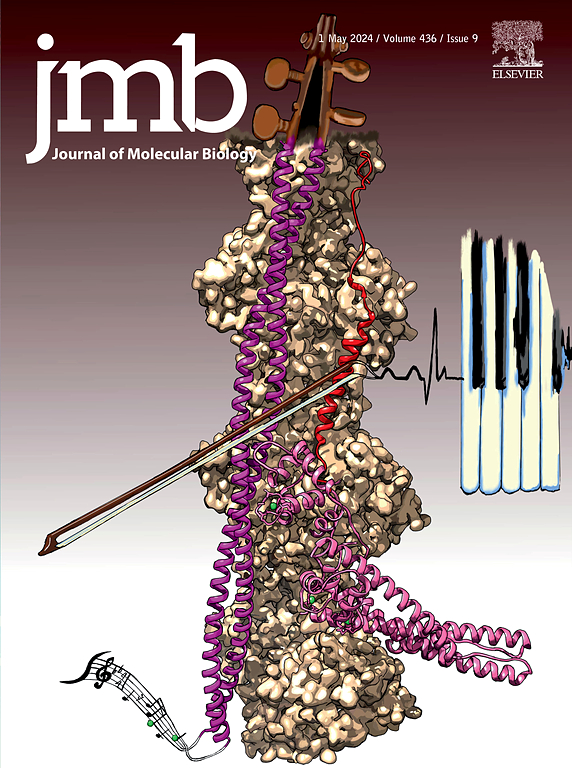人rna结合蛋白SMAUG1的凝聚形成受其内在无序区域和与14-3-3蛋白的相互作用控制。
IF 4.7
2区 生物学
Q1 BIOCHEMISTRY & MOLECULAR BIOLOGY
引用次数: 0
摘要
SMAUG1是一种在多种疾病中失调的人类rna结合蛋白(RBP)。它是进化保守的,并形成含有翻译抑制rna的凝聚体。这表明冷凝是SMAUG1功能的核心。在这项工作中,我们证明了SMAUG1 c端一半内的朊病毒样无序区域是驱动细胞中液体状凝聚物形成所必需的,但不是充分的。我们使用生化分析来表明SMAUG1液-液相分离(LLPS)似乎独立于RNA结合,并且不依赖于蛋白质的其他大的、无序的区域,这些区域可能包含伴侣蛋白的几个结合位点。结合计算预测、结构建模、体外和细胞测量,我们发现smaug1驱动的缩聚受到与14-3-3蛋白家族成员直接相互作用的负调控。这些相互作用由SMAUG1紊乱区域内至少四个不同的磷酸化调控短线性基序介导,协同工作。SMAUG1和二聚体14-3-3蛋白之间的相互作用驱动凝聚物的溶解,并可能与其他未知的调节机制交织在一起。有趣的是,单体14-3-3变异体不能诱导凝析溶解,这表明二聚体14-3-3蛋白对SMAUG1多肽链施加的构象约束,可能桥接远端结合位点,对于所描述的相分离调控机制很重要。我们的研究结果加强了最近关于14-3-3蛋白在生物缩聚中的一般调控作用的发现,并为SMAUG1相分离如何被调控提供了有价值的新见解。本文章由计算机程序翻译,如有差异,请以英文原文为准。

Condensate Formation of the Human RNA-binding Protein SMAUG1 is Controlled by its Intrinsically Disordered Regions and Interactions with 14-3-3 Proteins
SMAUG1 is a human RNA-binding protein (RBP) that is dysregulated in a wide range of diseases. It is evolutionarily conserved and forms condensates containing translationally repressed RNAs. This indicates that condensation is central to SMAUG1 function. In this work, we show that a prion-like disordered region within the C-terminal half of SMAUG1 is required, but not sufficient, to drive formation of liquid-like condensates in cells. We use biochemical assays to show that SMAUG1 liquid–liquid phase separation (LLPS) appears to be independent of RNA binding and does not depend on other large, disordered regions of the protein that potentially harbor several binding sites for partner proteins. Using a combination of computational predictions, structural modeling, in vitro and in cell measurements, we show that SMAUG1-driven condensation is negatively regulated by direct interactions with members of the 14-3-3 protein family. These interactions are mediated by at least four distinct phospho-regulated short linear motifs within the disordered regions of SMAUG1, working synergistically. Interactions between SMAUG1 and dimeric 14-3-3 proteins drive the dissolution of condensates and are likely intertwined with other unknown regulatory mechanisms. Interestingly, a monomeric 14-3-3 variant cannot induce condensate dissolution, suggesting that the conformational constraints imposed on the SMAUG1 polypeptide chain by dimeric 14-3-3 proteins, potentially bridging distant binding sites, are important for the described phase separation-regulatory mechanism. Our results reinforce recent findings on the general regulatory role of 14-3-3 proteins in biological condensation and provide valuable novel insights into how SMAUG1 phase separation is regulated.
求助全文
通过发布文献求助,成功后即可免费获取论文全文。
去求助
来源期刊

Journal of Molecular Biology
生物-生化与分子生物学
CiteScore
11.30
自引率
1.80%
发文量
412
审稿时长
28 days
期刊介绍:
Journal of Molecular Biology (JMB) provides high quality, comprehensive and broad coverage in all areas of molecular biology. The journal publishes original scientific research papers that provide mechanistic and functional insights and report a significant advance to the field. The journal encourages the submission of multidisciplinary studies that use complementary experimental and computational approaches to address challenging biological questions.
Research areas include but are not limited to: Biomolecular interactions, signaling networks, systems biology; Cell cycle, cell growth, cell differentiation; Cell death, autophagy; Cell signaling and regulation; Chemical biology; Computational biology, in combination with experimental studies; DNA replication, repair, and recombination; Development, regenerative biology, mechanistic and functional studies of stem cells; Epigenetics, chromatin structure and function; Gene expression; Membrane processes, cell surface proteins and cell-cell interactions; Methodological advances, both experimental and theoretical, including databases; Microbiology, virology, and interactions with the host or environment; Microbiota mechanistic and functional studies; Nuclear organization; Post-translational modifications, proteomics; Processing and function of biologically important macromolecules and complexes; Molecular basis of disease; RNA processing, structure and functions of non-coding RNAs, transcription; Sorting, spatiotemporal organization, trafficking; Structural biology; Synthetic biology; Translation, protein folding, chaperones, protein degradation and quality control.
 求助内容:
求助内容: 应助结果提醒方式:
应助结果提醒方式:


